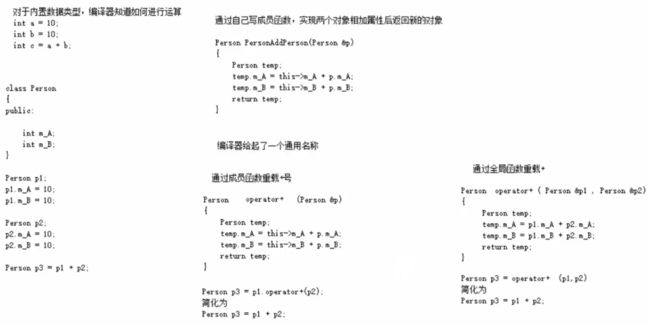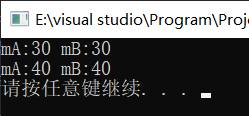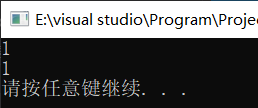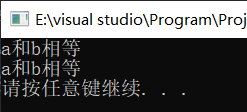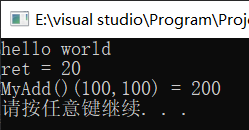【C++】运算符重载
目录
-
-
- 4.5 运算符重载
-
- 4.5.1 加号运算符重载
- 4.5.2 左移运算符重载
- 4.5.3 递增运算符重载
- 4.5.4 赋值运算符重载
- 4.5.5 关系运算符重载
- 4.5.6 函数调用运算符重载
-
橙色
4.5 运算符重载
运算符重载概念:对已有的运算符重新进行定义,赋予其另一种功能,以适应不同的数据类型
4.5.1 加号运算符重载
作用:实现两个自定义数据类型相加的运算
下面这段代码展示了如何利用成员函数实现以及如何利用全局函数实现+ 号运算符重载:
class Person {
public:
Person() {};
Person(int a, int b)
{
this->m_A = a;
this->m_B = b;
}
//成员函数实现 + 号运算符重载
Person operator+(const Person& p) {
Person temp;
temp.m_A = this->m_A + p.m_A;
temp.m_B = this->m_B + p.m_B;
return temp;
}
public:
int m_A;
int m_B;
};
//全局函数实现 + 号运算符重载
//Person operator+(const Person& p1, const Person& p2) {
// Person temp(0, 0);
// temp.m_A = p1.m_A + p2.m_A;
// temp.m_B = p1.m_B + p2.m_B;
// return temp;
//}
//运算符重载 可以发生函数重载
Person operator+(const Person& p2, int val)
{
Person temp;
temp.m_A = p2.m_A + val;
temp.m_B = p2.m_B + val;
return temp;
}
void test() {
Person p1(10, 10);
Person p2(20, 20);
//成员函数方式
Person p3 = p2 + p1; //相当于 p2.operaor+(p1)
cout << "mA:" << p3.m_A << " mB:" << p3.m_B << endl;
Person p4 = p3 + 10; //相当于 operator+(p3,10)
cout << "mA:" << p4.m_A << " mB:" << p4.m_B << endl;
}
int main() {
test();
system("pause");
return 0;
}
总结1:对于内置的数据类型的表达式的的运算符是不可能改变的
总结2:不要滥用运算符重载
4.5.2 左移运算符重载
作用:可以输出自定义数据类型
它只能通过全局函数来实现,使用成员函数无法得到想要的效果。
class Person {
friend ostream& operator<<(ostream& out, Person& p);
public:
Person(int a, int b)
{
this->m_A = a;
this->m_B = b;
}
private:
int m_A;
int m_B;
};
//全局函数实现左移重载
//ostream对象只能有一个
ostream& operator<<(ostream& out, Person& p) {
out << "a:" << p.m_A << " b:" << p.m_B;
return out;
}
void test() {
Person p1(10, 20);
cout << p1 << "hello world" << endl; //链式编程
}
int main() {
test();
system("pause");
return 0;
}
4.5.3 递增运算符重载
作用: 通过重载递增运算符,实现自己的整型数据
class MyInteger {
friend ostream& operator<<(ostream& out, MyInteger myint);
public:
MyInteger() {
m_Num = 0;
}
//前置++,之所以返回引用是因为有时会出现++(++a)这种连续递增的情况
MyInteger& operator++() {
//先++
m_Num++;
//再返回
return *this;
}
//后置++,之所以不返回引用是因为temp是局部变量,会被释放掉
MyInteger operator++(int) { //int代表站位参数,可以用于区分前置和后置递增
//先返回
MyInteger temp = *this; //记录当前本身的值,然后让本身的值加1,但是返回的是以前的值,达到先返回后++;
m_Num++;
return temp;
}
private:
int m_Num;
};
ostream& operator<<(ostream& out, MyInteger myint) {
out << myint.m_Num;
return out;
}
//前置++ 先++ 再返回
void test01() {
MyInteger myInt;
cout << ++myInt << endl;
cout << myInt << endl;
}
//后置++ 先返回 再++
void test02() {
MyInteger myInt;
cout << myInt++ << endl;
cout << myInt << endl;
}
int main() {
test01();
//test02();
system("pause");
return 0;
}
4.5.4 赋值运算符重载
c++编译器至少给一个类添加4个函数
- 默认构造函数(无参,函数体为空)
- 默认析构函数(无参,函数体为空)
- 默认拷贝构造函数,对属性进行值拷贝
- 赋值运算符 operator=, 对属性进行值拷贝
如果类中有属性指向堆区,做赋值操作时也会出现深浅拷贝问题
示例:
class Person
{
public:
Person(int age)
{
//将年龄数据开辟到堆区
m_Age = new int(age);
}
//重载赋值运算符 ,返回引用则是为了保证能连等,比如a=b=c
Person& operator=(Person &p)
{
//先判断是否由属性在堆区,如果有的话,释放干净
if (m_Age != NULL)
{
delete m_Age;
m_Age = NULL;
}
//编译器提供的代码是浅拷贝
//m_Age = p.m_Age;
//提供深拷贝 解决浅拷贝的问题
m_Age = new int(*p.m_Age);
//返回自身
return *this;
}
~Person()
{
if (m_Age != NULL)
{
delete m_Age;
m_Age = NULL;
}
}
//年龄的指针
int *m_Age;
};
void test01()
{
Person p1(18);
Person p2(20);
Person p3(30);
p3 = p2 = p1; //赋值操作
cout << "p1的年龄为:" << *p1.m_Age << endl;
cout << "p2的年龄为:" << *p2.m_Age << endl;
cout << "p3的年龄为:" << *p3.m_Age << endl;
}
int main() {
test01();
//int a = 10;
//int b = 20;
//int c = 30;
//c = b = a;
//cout << "a = " << a << endl;
//cout << "b = " << b << endl;
//cout << "c = " << c << endl;
system("pause");
return 0;
}
4.5.5 关系运算符重载
作用: 重载关系运算符,可以让两个自定义类型对象进行对比操作
示例:
class Person
{
public:
Person(string name, int age)
{
this->m_Name = name;
this->m_Age = age;
};
bool operator==(Person & p)
{
if (this->m_Name == p.m_Name && this->m_Age == p.m_Age)
{
return true;
}
else
{
return false;
}
}
bool operator!=(Person & p)
{
if (this->m_Name == p.m_Name && this->m_Age == p.m_Age)
{
return false;
}
else
{
return true;
}
}
string m_Name;
int m_Age;
};
void test01()
{
//int a = 0;
//int b = 0;
Person a("孙悟空", 18);
Person b("孙悟空", 18);
if (a == b)
{
cout << "a和b相等" << endl;
}
else
{
cout << "a和b不相等" << endl;
}
if (a != b)
{
cout << "a和b不相等" << endl;
}
else
{
cout << "a和b相等" << endl;
}
}
int main() {
test01();
system("pause");
return 0;
}
4.5.6 函数调用运算符重载
- 函数调用运算符 () 也可以重载
- 由于重载后使用的方式非常像函数的调用,因此称为仿函数
- 仿函数没有固定写法,非常灵活
示例:
class MyPrint
{
public:
void operator()(string text)
{
cout << text << endl;
}
};
void test01()
{
//重载的()操作符 也称为仿函数
MyPrint myFunc;
myFunc("hello world");
}
class MyAdd
{
public:
int operator()(int v1, int v2)
{
return v1 + v2;
}
};
void test02()
{
MyAdd add;
int ret = add(10, 10);
cout << "ret = " << ret << endl;
//匿名对象调用,通过MyAdd()创建了一个匿名对象
cout << "MyAdd()(100,100) = " << MyAdd()(100, 100) << endl;
}
int main() {
test01();
test02();
system("pause");
return 0;
}
